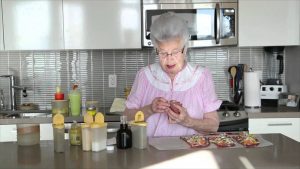Literature Review
By Sarah Rosenthal • December 12, 2018
Video Sources

Ed Fritz captures his mother’s charming personality and Hungarian accent in this unique YouTube cooking series. “Oma,” or “Grandma,” was born in Hungary in 1927 and immigrated to Canada in 1950, where she continues to make her authentic Hungarian recipes for her family, her friends, and her adoring YouTube subscribers. In this video, Oma makes her version of the often Americanized Hungarian dish goulash.
Cookbooks, Memoirs, and Academic Books

Sasvari, Joanne. Paprika: A Spicy Memoir from Hungary. CanWest Books, 2005.
Joanne Sasvari, a Canadian food writer, embarks on a journey to unravel and record her family’s Hungarian roots through family cookbooks, oral history, and her personal memories. Her Hungarian heritage and refined culinary perspective distinguish this book in the crowded memoir genre.

Lee Jolliffe’s compilation of academic research on spices and tourism features a chapter dedicated to the heart and soul of all Hungarian food: paprika. The authors of the article hypothesize that paprika is a symbol of Hungarian identity, and their brief yet deep analysis of paprika’s use and origins is key to understanding Hungarian cuisine, culture, and history.

This eleven-page cookbook is useful for the new cook who wants to try authentic Hungarian recipes on a budget. It is notoriously difficult to find restaurants which serve historically accurate dishes among the tourist traps in Hungary’s capital city. Budapest University of Technology and Economics’ study abroad office compiled these recipes to encourage their foreign exchange students to cook Hungarian cuisine.

Lang, George. George Lang’s Cuisine of Hungary. Wings Books, 1994.
The New York Times described this cookbook as “what cookbooks should be and almost never are.” Before the three hundred recipes which took him nearly fifteen years to research and experiment, Lang uses nearly 150 pages of to trace the history of the Hungarian cuisine, which makes this book an endlessly valuable source as the primary authority on Hungarian cuisine.
Popular Articles
This article breaks the most significant intricacies of the Hungarian cuisine into small, easily digestible chunks with enticing photographs. It briefly highlights the significances of paprika, stews, pork, market halls, layered cakes, and wine to Hungarian culture.
Cameron Hewitt makes a mockery of people with preconceived notions of dreadful and bleary Eastern European cuisines with his gorgeous, striking personal photographs and mouthwatering descriptions of Hungarian food, from the beautifully ornate meals he’s eaten in restaurants to the fried cones of dough he’s eaten from street carts. Like all lovers of Hungarian food, Hewitt has a deep love of paprika, and describes how to ask for certain varieties to add a spicy heat to some of Hungary’s most popular dishes.
Scholarly Articles
Maxwell, Alexander. “National Alcohol in Hungary’s Reform Era: Wine, Spirits, and the Patriotic Imagination.” Central Europe, vol. 12, no. 2, Nov. 2014, p. 117.
It’s impossible to discuss Hungarian cuisine without touching on famous Hungarian wine. This article discusses how Hungarian wine became the staple it is today, and the history of its representation of nationalism, ethnic conflict, and class constructs.
Vasvári, Louise O. “Identity and Intergenerational Remembrance Through Traumatic Culinary Nostalgia: Three Generations of Hungarians of Jewish Origin.” Hungarian Cultural Studies, vol. 11, 2018, pp. 57-77.
This study is a heart-wrenching exploration of the importance of the national cuisine of Hungary to the identity and survival of Holocaust victims. As the few Jewish Hungarians who survived the Holocaust begin to die of old age, Vasvári offers a solution to reshaping and retaining their memories by going back to methods of recipe creation which helped them survive the atrocities they experienced and preserving them for the future.